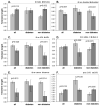Leukocyte telomere length is associated with disability in older u.s. Population
- PMID: 20579170
- PMCID: PMC2918372
- DOI: 10.1111/j.1532-5415.2010.02948.x
Leukocyte telomere length is associated with disability in older u.s. Population
Abstract
Objectives: To determine whether mean leukocyte telomere length (LTL) serves as a biomarker of disability assessed according to activities of daily living (ADLs) and what factors may modify this relationship.
Design: Retrospective cross-sectional study.
Setting: A subset of the National Long Term Care Survey (NTLCS), a Medicare-based U.S. population longitudinal study focused on trends of overall health and functional status in older adults.
Participants: Six hundred and twenty-four individuals from the 1999 wave of the NTLCS cohort.
Measurements: Relative LTL determined according to quantitative polymerase chain reaction. LTL has previously been shown to correlate with common age-related disorders and mortality, as well as with socioeconomic status.
Results: A sex difference in LTL was observed but not age-dependent shortening or association with socioeconomic status. LTL was associated with disability and functional status assessed according to ADLs. The association between ADLs and LTL was stronger in subjects without diabetes mellitus, whereas associations were not seen when only subjects with diabetes mellitus were analyzed. Associations between LTL and cardiovascular disease (CVD) and cancer were also present in the group without diabetes mellitus but not in the group with diabetes mellitus.
Conclusion: These findings support the concept that LTL is a biomarker of overall well-being that is predictive of disability of older individuals in the U.S. population. Diabetes mellitus plays an important role as a modifier of the association between LTL and disability, CVD, and cancer. These associations have clinical implications because of the potential predictive value of LTL and deserve further investigation.
Conflict of interest statement
Figures

References
-
- Blackburn EH. Telomere states and cell fates. Nature. 2000;408:53–56. - PubMed
-
- Aviv A. Telomeres and human aging: Facts and fibs. Sci Aging Knowledge Environ. 2004;2004:pe43. - PubMed
-
- Wong JM, Collins K. Telomere maintenance and disease. Lancet. 2003;362:983–988. - PubMed
-
- Tchirkov A, Lansdorp PM. Role of oxidative stress in telomere shortening in cultured fibroblasts from normal individuals and patients with ataxia-telangiectasia. Hum Mol Genet. 2003;12:227–232. - PubMed
-
- Demissie S, Levy D, Benjamin EJ, et al. Insulin resistance, oxidative stress, hypertension, and leukocyte telomere length in men from the Framingham Heart Study. Aging Cell. 2006;5:325–330. - PubMed
Publication types
MeSH terms
Substances
Grants and funding
LinkOut - more resources
Full Text Sources

